Infield Fly Rule - Explained
The purpose of the Infield Fly Rule is to prevent the defense from getting a double play, while the offense has no opportunity to avoid it.
For instance, there is 1 out, with runners on First and Second Base. The batter hits a medium high fly ball pop up to the third baseman, who doesn’t even have to move to catch the ball.
The runners must remain at their bases or risk being doubled up, fly ball caught … throw to base beats runner, who’s off the base, attempting to return.
The third baseman allows the ball to drop to the ground at his feet, or smarter yet, actually catches the ball for an instant before allowing it to pop out of his glove and drop to the ground, which minimizes the risk of the ball hitting the ground and bouncing away from the fielder.
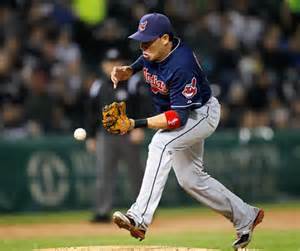
Batter Still Out
The third baseman simply picks the ball up, tags third base for a force out, out 2, then throws to second base for another force out, out 3, and there was absolutely no way the offense could have avoided being doubled up.
Had the runners tried to advance in order to stay out of a force out double play, the third baseman would simply catch the fly ball for out 2, then throw to second or first base to complete the double play.
The Infield Fly Rule, which calls the batter out, is called when there are runners on 1st and 2nd with less than 2 outs, or bases loaded with less than 2 outs.
This Rule appears to be pretty straight forward, why the confusion?
Not knowing the elements, which must be place in order to call an Infield Fly Rule, is the number one culprit of the confusion. Some people think with a man on first base, less than 2 out and an infield pop up occurs, it constitutes an infield fly rule, it Doesn’t.
Can the Defense turn a double play under such circumstances? Most definitely. Can the Offense avoid the double play? Most definitely and that’s the key. All the offense has to do to avoid a double play in this scenario, is to have the batter finish running to first base.
If the ball is caught, the batter’s out. If the ball is dropped, most likely the runner will be forced out at second base, but the batter will be safe at first. The only way the defense can turn a double play is to drop the ball, tag second and beat the batter to first with the ball, which can only happen if the batter Does Not Run. If that occurs … oh well, they need to be doubled up.
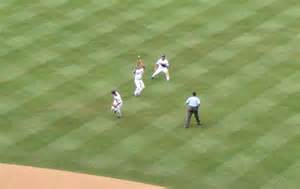
Infield Fly Rule or Not?
Now that everyone is educated on what elements must be in place for the Infield Fly Rule to apply, let’s go to the next confusing issue.
The Infield Fly Rule is a Subjective call by the Umpire, which means the umpire has the discretion of calling or not calling an infield fly rule out.
With runners on first and second, one out and a little pop fly is hit to the third baseman, if the umpire thinks the fielder can catch the pop up with Ordinary or Normal Effort, the umpire will yell “ Infield Fly Rule … Batter Out !”
In other words, Ordinary or Normal Effort, means the third baseman simply waits for the ball to come down to catch it, without moving or moving very little, a catch made 99% of the time, the Rule will be called.
However, let’s look at this. Same situation, runners on first and second, 1 out. The infield is playing for a sacrifice bunt, which means the third baseman is charging towards home plate as the pitcher throws. (In this particular situation the shortstop is going to cover second base, not third.)
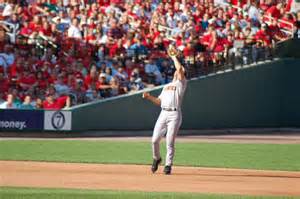
Catch
The batter hits a little pop fly blooper which will land fair 3 feet from third base, an easy catch.
However, the umpire Does Not call the automatic infield fly rule out. Why? Because the third baseman is now closer to home plate than third base and must stop, reverse his direction and either get back in time to catch the ball or else catch it over his shoulder. This catch would Not qualify as Ordinary or Normal effort.
The exact same situation, yet two completely different calls or non-calls by the umpire, and both are correct.
Another Confusing Issue:
It is possible for the umpire to invoke the rule “Infield Fly …Batter Out!” and yet the batter will Not be out. How can that happen?
The rule is intended to apply to balls Only in Fair territory. Runners on First and Second, 1 out, the batter hits a high fly ball to the third baseman, and the umpire immediately yells “Infield Fly … Batter Out!”
However, as the ball comes down it floats into Foul territory, where it’s either caught or not caught. The Infield Fly Rule does not apply now, because the ball is in Foul territory. The ball will either be caught, and the batter is out…or the ball is not caught, which the ball just becomes a foul ball.
Umpires are trained, or are suppose to be trained, to yell “ Infield Fly Ball .. If it stays fair,” but you rarely hear that said. If the ball drops and is not caught, the proper call for the umpire is “Foul Ball .. Batter is Not Out.”
Here’s another example. Infield Fly Rule applicable, the ball is hit straight up between the catcher and pitcher. The umpire yells “Infield Fly, Batter Out,” but the ball lands between the oncoming pitcher and outgoing catcher, neither able to catch the ball. The extreme back spin on the ball takes it into foul territory before being touched. The Infield Fly becomes null and void and the ball becomes a foul ball, batter still batting.
Not done yet. Rule applicable, the batter hits a high fly ball to the first baseman, the umpire invokes the infield fly rule, but the first baseman misses the ball, it hits fair past the base, then rolls foul. Since the ball hit in Fair territory and normally would have been a base hit, and the catch would have normally been made, the infield fly rule does apply and the batter is out.
In a situation like this, the base runners are able to advance at their own risk. ****
How can an Infield Fly Rule be called when the Outfielder caught the ball?
One must always keep in mind the Umpire has total discretion on when to enforce the infield fly. A pop fly is hit to the shortstop, and the shortstop must back peddle 3 or 4 steps, which puts him in the Outfield Grass, the umpire decides the shortstop could catch the ball with ordinary effort, he has the right to invoke the rule.
What if a pop fly is hit to the second baseman 3 or 4 feet into the outfield grass, and the Right Fielder calls the second baseman off and makes the catch instead. Can this be called an infield fly?
The umpire, most likely the field umpire, will position himself in a manner where he can estimate where the ball will come down at, and decide whether in his opinion, the second baseman can catch the ball with ordinary effort. Should he decide yes, he’ll call “Infield Fly…Batter Out!” If the outfielder calls off the second baseman because he has an easier catch coming in … it still qualifies as an infield fly rule.
Base Runners Beware:
1.As a base runner or coach, Never assume an infield fly will be called by the umpire. The runner must always be prepared to run in the event the call is not made.
2. Base Runners can advance, at their own risk, whether the rule is called or not. If the ball is caught, they must tag up before advancing, and if the ball is not caught, they don’t need to tag up.
3. Never forget, if the rule is called, the force out has been eliminated and the runner Does Not have to run, because the batter has been called out.
One More Confusing Rule:
What about a bunted ball, which is popped up instead of hitting the ground, or a line drive to an infielder, are these two examples Infield Fly Outs? NO.
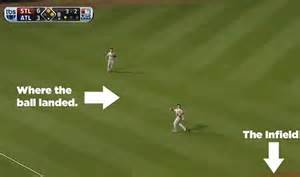
Infamous Infield Fly Call & Shortstop Blunder
These two examples are covered by another rule which deals with the defense dropping a ball in order to gain an unfair advantage.
Example; Runner on first base, 1 out and Due to a defensive shift the second baseman is literally 4 feet away from second base. The batter hits a soft line drive directly at the him, but instead of catching the easy line drive, the second baseman knocks the ball down to the ground in front of him, with the intentions of picking the ball up, tagging second for a force out and throwing on to first for the double play. The rule governing this play states the Batter is Out.
There are 3 major differences compared to the infield fly rule.
1. The rule applies to all infield fly situations governing runners and with a runner on first base or first and third base.
2. The Umpire Must call the infield fly rule while the ball is in the air. However, this rule can be called After the play has happened.
3. If the umpire makes this call, the ball is automatically “dead” and runners must return to their bases, as nobody is allowed to advance.
Warning !!!
This rule is not an automatic call. If the second baseman had let the soft line drive hit the ground first, although he could have easily caught it on the fly, the rule does not apply and the defense could get a double play.
***One last Tip for umpires.*** Umpires must communicate. When an infield fly rule situation presents itself, runners on first and second less than 2 outs, remind one another of the fact, by simply giving a two thumbs up signal to each other. Umpires must be just as prepared to call a game as the players are to play it.
Infield Fly Rule to Learn Youth Baseball Coaching
Umpire Baseball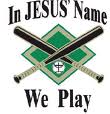
New! Comments
Have your say about what you just read! Leave me a comment in the box below.